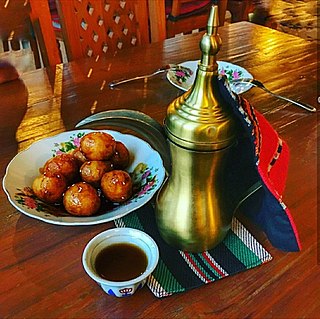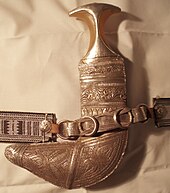
Kuwait is well known in the region for its exploration of many different and new forms of music and dance. Kuwait is the birthplace of various popular musical genres such as sawt. Kuwait is widely considered the centre of traditional music in the GCC region.
The music of Oman has been strongly affected by the country's coastal location, with Omani sailors interacting with, and bringing back music from, Egypt, Tanzania and elsewhere. More recently, a Portuguese occupation has left its own marks, while geographic neighbors like the United Arab Emirates, Yemen, Saudi Arabia and Iran have also had a profound influence. In contrast to other Arab countries, Omani traditional music has a strong emphasis on rhythm.

Culture of Kuwait describes the cultural aspects of the Kuwaiti society and is part of the Eastern Arabian culture. Kuwaiti popular culture, in the form of dialect poetry, film, theatre, radio and television soap opera, flourishes and is even exported to neighboring states. Within the Arab states of the Persian Gulf, the culture of Kuwait is the closest to the culture of Bahrain.

The Gulf rupee was the official currency used in the British protectorates of the Arabian Peninsula that are around the Persian Gulf between 1959 and 1966. These areas today form the countries of Kuwait, Bahrain, Qatar, Oman, and the United Arab Emirates. It was issued by the Government of India and the Reserve Bank of India and was equivalent to the Indian rupee.

The Arab states of the Persian Gulf or the Arab Gulf states refers to a group of Arab states bordering the Persian Gulf. There are seven member states of the Arab League in the region: Bahrain, Kuwait, Iraq, Oman, Qatar, Saudi Arabia, and the United Arab Emirates. Yemen is bound to the six countries of the Gulf Cooperation Council, based on history and culture.
The Bahārna are an ethnoreligious group of Shia Muslim Arabs indigenous to the historical region of Bahrain. They are generally regarded to be the original inhabitants of Eastern Arabia. They inhabited the area even before the arrival of the Banu Utbah in the 18th century which the Bahraini royal family descends from. Most Bahraini citizens are Baharna. Regions with most of the population are in Eastern Arabia, with significant populations in Kuwait, United Arab Emirates, Qatar, Oman, Iraq, and Hormozgan province of Iran.

Bahrani Arabic is a variety of Arabic spoken by the Baharna in Eastern Arabia and Oman. In Bahrain, the dialect is primarily spoken in Shia villages and some parts of Manama. In Saudi Arabia, the dialect is spoken in the governorate of Qatif. In Oman, it is spoken in the governorates of Al Dhahirah and Al Batinah.
The culture of Bahrain is part of the historical region of Eastern Arabia. Thus, Bahrain's culture is similar to that of its Arab neighbours in the Persian Gulf region. Bahrain is known for its cosmopolitanism, Bahraini citizens are very ethnically diverse. Though the state religion is Islam, the country is tolerant towards other religions: Catholic and Orthodox churches, Hindu temples as well as a (now-defunct) Jewish synagogue are present on the island.

Eastern Arabia (Bahrain), is a region stretched from Basra to Khasab along the Persian Gulf coast and included parts of modern-day Bahrain, Kuwait, Iraq, Eastern Saudi Arabia, United Arab Emirates, Qatar, Oman. The entire coastal strip of Eastern Arabia was known as "Bahrain" for a millennium.

Al-Ahsa Oasis, also known as al-Ḥasāʾ (الْحَسَاء) or Hajar (هَجَر), is an oasis and historical region in eastern Saudi Arabia. Al-Ahsa Governorate, which makes up much of the country's Eastern Province, is named after it. The oasis is located about 60 km (37 mi) inland from the coast of the Persian Gulf. Al-Ahsa Oasis comprises four main cities and 22 villages. The cities include Al-Mubarraz and Al-Hofuf, two of the largest cities in Saudi Arabia.

Kuwaiti cuisine is a fusion of Arabian, Iranian, Indian and Mediterranean cuisines. Kuwaiti cuisine is part of the Eastern Arabian cuisine. A prominent dish in Kuwaiti cuisine is machboos, a rice-based dish usually prepared with basmati rice seasoned with spices, and chicken or mutton.

Eastern Arabian cuisine, also called Khaleeji cuisine, is the traditional Arabic cuisine variant that is shared by the population in Eastern Arabia and areas around the Persian Gulf. Seafood is a significant part of the diet of the inhabitants of the coastal region of Eastern Arabia. Fish is popular. The cuisine of eastern Arabia is different from the cuisine of the Arabs of Hejaz, Yemen, Najd, Oman, and other parts of Arabia. Harees is also a popular dish in the region.

The Emiratis are the native citizen population of the United Arab Emirates. Within the UAE itself, they number approximately 1.15 million.
Fann aṭ-Ṭanbūra is a traditional music and dance genre in the Arab states of the Persian Gulf, especially Bahrain, Kuwait and Oman. Musically, the tanbūra instrument plays a central role, along with several drums and the manjur— an instrument made from a large number of goat hooves attached to a type of apron which is wrapped around the waist of the performer.

Emirati cuisine is the local traditional Arabic cuisine of the United Arab Emirates. It is part of Eastern Arabian cuisine and shares similarities with cuisines from neighboring countries, such as Omani cuisine and Saudi Arabian cuisine, as well as influences from different Middle Eastern and Asian cuisines.

The culture of the United Arab Emirates is part of the culture of Eastern Arabia. Its historical population was a small tribal community that changed with the arrival of an influx of foreign nationals in the mid-20th century. Emirati culture is a blend of Arabian, Islamic, and Persian cultures, with influences from the cultures of East Africa and Indian Subcontinent. Islam has had a prominent influence on local architecture, music, attire, cuisine, and lifestyle.
Gargee'an, sometimes spelled as Gerga'oon, is a semiannual celebration, observed primarily in Eastern Arabia. It takes place on the 15th night of the Islamic month of Sha'ban for Shia Muslims and on the 15th night of Ramadan for all sects. It is celebrated by children and adults alike dressing in traditional attire and going door-to-door to receive sweets and nuts from neighbours, as they sing traditional songs. It’s more of a tradition than a religious affiliation so both Sunni and Shia celebrate it. The tradition has existed for hundreds of years, and is deeply rooted in some parts of the Gulf culture, especially in Iraq, Kuwait, Bahrain and Saudi Arabia.

Omani cuisine is part of the Khaleeji cuisine and is influenced by Arab, Pakistani cuisine, Iranian, Indian, Asian, Eastern Mediterranean, and African cuisine, reflecting Oman's position as a vast trading empire at the intersection of traditional spice trade routes. Dishes are often based on chicken, fish, and lamb, as well as the staple of rice. Most Omani dishes tend to contain a rich mixture of spices, herbs, and marinades. Omani cuisine differs from other cuisines in the Arabian peninsula, as it is less spicy and seldom served warm.

Peninsular Arabic are the varieties of Arabic spoken throughout the Arabian Peninsula. This includes the countries of Saudi Arabia, Yemen, Oman, United Arab Emirates, Kuwait, Bahrain, Qatar, Southern Iran, Southern Iraq and Jordan.
Huwala also collectively referred to as Bani Huwala, is a blanket term usually used to refer to Iranian Arabs of tribal lineage who initially migrated to Iran in the 13th and 14th century and intermixed with the indigenous population of older Arabic-speaking background. Such migrations continued till around 19th century to the area which is now Iran's Hormozgan Province and Fars Province, mainly Bandar Abbas, Qishm, and the mainland near Bandar Lengeh. The Huwala follows Sunni Islam, as opposed the majority Persian Twelver Shia and similar to Sunni Peninsular Arabs. Most of the Huwala have remigrated back to the Arabian Peninsula between late 19th century and early 20th century. The imposition of restrictive economic policies by Reza Shah in the 1930s led to the migration of most of the Huwala back to the Arabian Peninsula.















